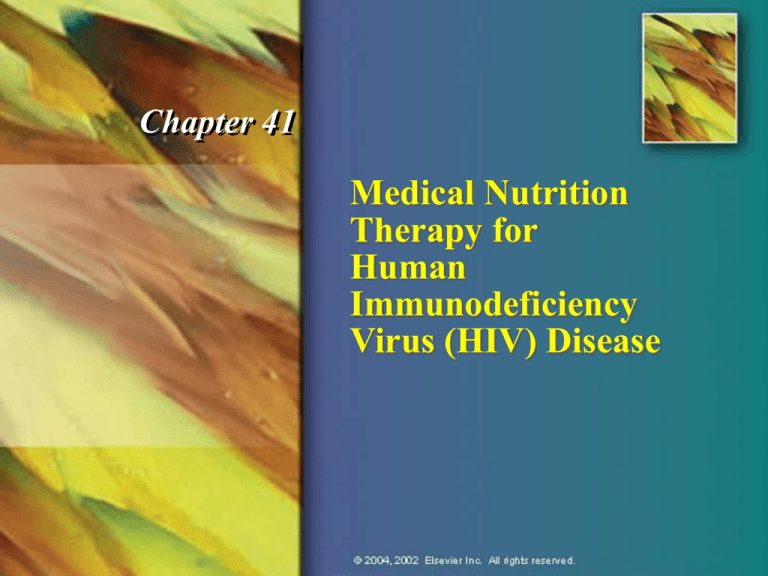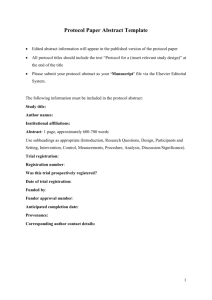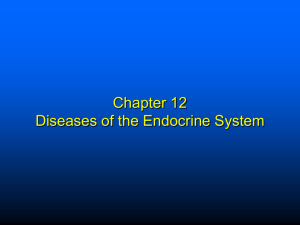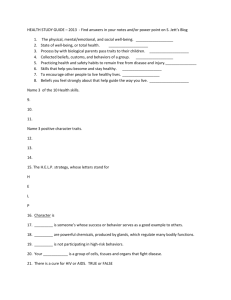
Chapter 41
Medical Nutrition
Therapy for
Human
Immunodeficiency
Virus (HIV) Disease
Human Immunodeficiency Virus
HIV is a virus that targets the body’s
immune system and inhibits a person’s
body from producing adequate immune
defenses.
This virus can develop into AIDS
over time.
© 2004, 2002 Elsevier Inc. All rights reserved.
Acquired Immunodeficiency
Syndrome
AIDS is the final stage of HIV.
AIDS is a disease that prevents the
body’s ability to fight off infection
and illness.
© 2004, 2002 Elsevier Inc. All rights reserved.
HIV and AIDS
Opportunistic infections and rare skin
cancer, Kaposi’s sarcoma, depressed cellular
immunity are common.
HIV virus destroys the T helper cells or T4.
Acute phase of infection 2 wks; 8 wks later,
test positive for HIV infection
© 2004, 2002 Elsevier Inc. All rights reserved.
HIV Infection
30% to 60% develop an acute syndrome
with malaise, fever, pharyngitis,
lymphadenopathy, headache, myalgia,
and sometimes a rash
© 2004, 2002 Elsevier Inc. All rights reserved.
Risk Factors for Contracting HIV
HIV can be transmitted through four different
types of fluids that can enter the bloodstream
1. Blood
2. Semen
3. Vaginal fluids
4. Breast milk (mother)
Fluids such as saliva, sweat, tears, and urine do
not transmit the virus, but HIV antibodies may
be present in these fluids.
© 2004, 2002 Elsevier Inc. All rights reserved.
People at Risk for HIV
Heterosexuals with more than one sex
partner
Hemophiliacs—inability to clot blood
These people have many blood transfusions.
Homosexual or bisexual males
Intravenous drug users
Infants with HIV-positive mothers
© 2004, 2002 Elsevier Inc. All rights reserved.
Acquired Immunodeficiency
Syndrome
Diagnosed when a person has HIV
infection and CD4 cell count below 200
or less than 14%
Dementia, wasting syndrome,
malignancies such as Kaposi’s sarcoma,
or one of more than 26 opportunistic
infections
© 2004, 2002 Elsevier Inc. All rights reserved.
Diagnosis of HIV and AIDS
Tests
– ELISA an immunosorbent assay—
Check for antibodies of HIV
(2 weeks’ postexposure)
– Western blot—more accurate but
not 100%
– Polymerase chain reaction (PCR)—
detects viral nucleic acids in virus;
most sensitive
© 2004, 2002 Elsevier Inc. All rights reserved.
Symptoms of HIV and AIDS
Early: fever
Weight loss
Diarrhea
Flulike
Later: opportunistic infections
Malignancies
© 2004, 2002 Elsevier Inc. All rights reserved.
Common Problems in HIV/AIDS
Fungus infections: thrush
Meningitis
Pneumonia
Protozoal infections—infection in large
and small bowels
Viral infections—herpes; shingles
© 2004, 2002 Elsevier Inc. All rights reserved.
Lipodystrophy
Reported among people taking any of the
licensed protease inhibitors
Disturbed fat metabolism
Loss of thin layer of fat; veins protrude
Wasting of face and limbs
Accumulated fat in abdomen under skin
and inside body cavity or between
shoulder blades
© 2004, 2002 Elsevier Inc. All rights reserved.
HIV Medical Management
The goals of medical management of HIV are to:
Prolong life and improve the quality of life for
the long term
Suppress the virus to as low a level as possible
for as long as possible
Optimize and extend the usefulness of currently
available therapies
Minimize drug toxicity and manage
side effects
© 2004, 2002 Elsevier Inc. All rights reserved.
Nutritional Assessment
Nutritional assessment: necessary for detecting
and reducing HIV and AIDS malnutrition
After diagnosis of HIV, nutritional screening
should be performed immediately while still
clinically asymptomatic.
Through biochemical measurements, serum levels
of vitamins and minerals can be obtained to
identify micronutrient deficiencies.
Three major components of nutritional assessment
include medical diet history, physical assessment,
and laboratory studies.
© 2004, 2002 Elsevier Inc. All rights reserved.
Nutritional Assessment—cont’d
Serum proteins can be measured to assess
visceral protein status.
Measuring cellular levels of nutrients
such as liver store of vitamin A or
leukocyte levels of vitamin C may be a
valid method of assessing body stores.
Hypoalbulminemia is associated with
reduced survival in people with AIDS.
© 2004, 2002 Elsevier Inc. All rights reserved.
Nutritional Assessment—cont’d
Percent UBW more important than
percent IBW—patients don’t lose fat
as much as lean
TLC and delayed cutaneous
hypersensitivity not helpful
© 2004, 2002 Elsevier Inc. All rights reserved.
HIV Assessment
Baseline status at diagnosis
Follow and reassess as complications
develop
Consider mental status
Misinformation
Knowledge of food sanitation and
good nutrition
© 2004, 2002 Elsevier Inc. All rights reserved.
General Goals of Nutrition
Intervention in HIV Disease
Preserve optimal somatic and visceral
protein status
Prevent nutrient deficiencies or excesses
known to compromise immune function
Minimize nutrition-related complications
that interfere with either intake or
absorption of nutrients
Support optimal therapeutic drug levels
Enhance the quality of life
© 2004, 2002 Elsevier Inc. All rights reserved.
Nutritional Goals
A combination of nutrition support and
drug therapy allows people with HIV and
AIDS to live longer, better-quality lives.
Maintain good nutrition and exercise to
improve health and slow down HIV
infection.
Prevent weight loss.
© 2004, 2002 Elsevier Inc. All rights reserved.
Medical Nutrition Therapy Requires
Six Distinct Components
Screening
Referral
Assessment
Intervention
Outcomes evaluation
Communications
© 2004, 2002 Elsevier Inc. All rights reserved.
Management of Symptoms in
HIV/AIDS
Nausea and vomiting
Loss of appetite
Sore mouth and throat
Diarrhea
Poor absorption of nutrients
Abdominal cramping
Weight loss
© 2004, 2002 Elsevier Inc. All rights reserved.
Eating Tips for Common Symptoms
Lack of appetite
—Eat favorite foods often.
—Eat snacks or a small meal every 2 to 3 hours.
—Go for a short walk or exercise to boost appetite.
Nausea and vomiting
—In the morning eat crackers, dry toast, or dry cereal.
—Avoid greasy, fried, or very sweet foods such as
french fries, pastries, and ice cream.
—Sip on flat sodas, weak ginger tea, or mint tea.
© 2004, 2002 Elsevier Inc. All rights reserved.
Eating Tips for Common
Symptoms—cont’d
Sore mouth and throat
—Try soft smooth foods, like mashed potatoes,
applesauce, baby foods, and cream soups.
—Avoid foods that sting or irritate the mouth, like
orange or tomato juice, hot sauces, and salty foods.
—Eat cold foods, such as Popsicles or ice cream.
Diarrhea
—Eat foods like bananas, applesauce, rice, and gummy
candy.
—Cut back on fatty foods.
—Cut down on fiber in the diet.
© 2004, 2002 Elsevier Inc. All rights reserved.
Suggested Diets for HIV/AIDS
Patients
Diets rich in fruits and vegetables that includes
iron, vitamin E, and riboflavin may delay the
development of full-blown AIDS.
There have been many alternative therapies that
include nutrition-based options such as
megadoses of nutrients, Dr. Berger’s Immune
Power Diet, and macrobiotic diet.
Most of these diets are low in fat and calcium
and high in fiber. They have not been proven
effective.
© 2004, 2002 Elsevier Inc. All rights reserved.
Roles of the Dietitian
Guiding the patient with emotional support,
proper nutrition, and incorporating exercise into
the daily routine are some of the challenges
dietitians face.
Monitor body composition and hormone levels
to improve body composition.
Monitor blood lipid, sugar levels, diet, and
medications to prevent hyperlipidemias and
elevated blood sugars.
© 2004, 2002 Elsevier Inc. All rights reserved.
Wasting Syndrome
Wasting syndrome is defined as the unexplained
weight loss of more than 10%, and is
accompanied by fever or diarrhea for 30 days.
It is considered a condition that is an indicator
for AIDS.
It is a multifactorial condition that can be
associated with variety of infectious, neoplastic,
metabolic, and nutritional abnormalities.
© 2004, 2002 Elsevier Inc. All rights reserved.
Nutritional Calculations
Energy—HB for BEE
Add injury factors
x 1.3 maintenance or 1.5 weight gain
Protein
1 to 1.4 g/kg/day maintenance
1.5 to 2.0 g/kg/day repletion
Fat—adjust for malabsorption
© 2004, 2002 Elsevier Inc. All rights reserved.
Nutritional Calculations—cont’d
Fluids and electrolytes
Consider symptoms and replace for fever,
diarrhea, night sweats, vomiting
Vitamins and minerals
Increased needs for ß-carotene, E, C, B12, B6,
folate
© 2004, 2002 Elsevier Inc. All rights reserved.
Food Safety Suggestions
Wash hands with hot soapy water before
touching or eating foods.
Cook meat, poultry, fish, and eggs until they are
well done.
Wash fresh fruits and vegetables thoroughly.
Drink filtered water.
Wash dishes and cutting boards in hot soapy
water.
Use leftovers in refrigerator within 2 days.
© 2004, 2002 Elsevier Inc. All rights reserved.
Strategies for Reducing the Risk
of Cryptosporidiosis
Data from Centers for Disease Control and Prevention. Cryptosporidiosis: a guide for persons with HIV/AIDS, Atlanta, 1995, CDC.
© 2004, 2002 Elsevier Inc. All rights reserved.
Nutrition-Related Complementary
and Alternative Therapies
Herbs/botanicals
—Astragalus
—Cat’s claw
—Echinacea
—Garlic
—Ginseng
—St. John’s wort
Megadoses of
vitamins and minerals
Antiviral AL-721 and
homemade formulas
Dr. Berger’s Immune
Power Diet and
maximum immunity
diet
Homeostatic
macrobiotic diet
Medical marijuana
Yeast-free diet
© 2004, 2002 Elsevier Inc. All rights reserved.
Drug Therapy
Antiretroviral drugs—they block the core
enzyme reverse transcriptase that is necessary
for viral replication and terminate DNA chain
formation
Examples:
—AZT (Retrovir)
—Videx
—Epivir
© 2004, 2002 Elsevier Inc. All rights reserved.
Drug Therapy—cont’d
Protease inhibitors—prevent the formation of
mature infectious viruses (they work late in the
viral cycle and block the activity of the viral
protease)
Examples:
—Norvir
—Invirase
—Crixivan
© 2004, 2002 Elsevier Inc. All rights reserved.
Drug Therapy for Involuntary
Weight Loss
Medicine used to promote weight gain after
involuntary weight loss as a result of surgery,
infections, or severe trauma.
Oxandrin—increases protein synthesis in the
skeletal muscle and improves intracellular
reutilization of amino acids. It works
synergistically with dietary protein.
© 2004, 2002 Elsevier Inc. All rights reserved.
Nutritional Referral
Referral information should include the following:
Consent to release medical information
Current diagnosis and medical history
Referring health care provider’s nutrition
prescription or desired outcome
Clinical symptoms and feeding route
Weight history and body composition
Recent biochemical data
© 2004, 2002 Elsevier Inc. All rights reserved.
Nutritional Referral—cont’d
Referral information should include the following:
Current medications (prescription and
nonprescription drugs, vitamins, minerals, and
other dietary supplements)
Use of complementary and alternative therapies
Functional status
Lifestyle, psychosocial status, and
activity/exercise routine, including substance
use pattern
© 2004, 2002 Elsevier Inc. All rights reserved.




